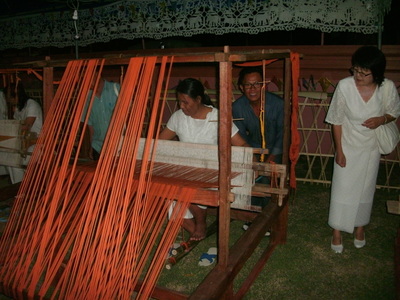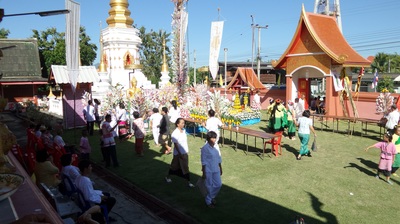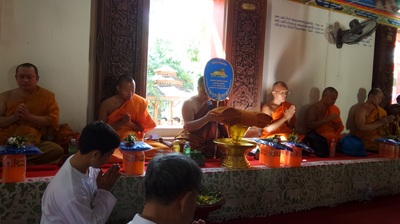|
Traditionally the Buddhist rainy season retreat, often called “Buddhist Lent”, ends with katin processions to bring new sets of saffron colored garments to monks. There are three to seven pieces to a set: a long, loose sleeveless shirt without the right shoulder, a knee-length sarong, and a long over-robe to be wrapped around the torso and arms in various ways depending on circumstances, a belt, a cloth for receiving items formally, and two other optional pieces. There may also be a folded rectangular cloth to be draped over the left shoulder on special occasions inside a temple precinct. Buddhist faithful, especially family members, brought a new set to their ordained relatives to help them be ready to go “out and about” as the lenten sequestration ended.
Nowadays it is likely that monks have several sets because they receive them on many occasions. Anyhow, a katin is conducted to bring not only robes but also large monitary gifts for temple upkeep or construction. A donor, wishing to make merit, first requests permission to conduct a katin and then becomes the festival’s sponsor. Since a temple can only receive one katin a year, the sponsor may actually be a group of co-sponsors. Members of the temple community act as appreciative hosts and join in the “procession” by bringing their own money trees. The sponsor is given a warm reception and the crowd usually circumambulates the temple’s main hall or chedi three times. Then there are formalities in the presentation and bestowing of blessings, followed by a meal provided by the community for the sponsors. Katins are multi-faceted merit-making events. Merit is compounded, through the subtle economics of religious calculation, by the amount of piety involved. Intense effort adds merit. Long pilgrimages are more meritorious than short ones. Mass ordinations are more meritorious for participants than individual ones. This appears to be the principle behind a chulakatin จุฬากฐิน such as the one I witnessed November 21-22, 2015 at Wat Ta Pong near our village. Whereas, a katin is the presentation of money trees and robes, a chulakatin is the presentation of very large money trees and robes made of cotton collected, spun, and woven within a single uninterrupted day. The extraordinary effort this requires produces compound merit. The abbot of Wat Ta Pong explained that in their case some short-cuts had been taken. The effort was symbolic, a demonstration of what the chulakatin festivals of old had been like. It was impressive. Beginning at dusk the community gathered. The first event was a service to invoke the presence and blessing of the spirits of the ancestors and of the weaver masters of old. Offerings of fruit and flowers were made. Then a company of classical dancers led the assembly through a symbolic cotton field. The cotton was attached to potted trees for this purpose, just outside the temple gate. The bolls were piled onto lacquer pedestal-trays to be carried into the temple grounds. The cotton was paraded before the ancestors and then turned ceremoniously over to workers who were waiting. Every step in the process was represented. The bolls were symbolically de-seeded, while some of them were already being spun into thread and wound onto bobbins. Meanwhile, weavers had loaded looms ready to operate with orange thread. All operations began at once. The need to dye the thread with saffron or dye made from certain trees was (from my perspective) the only step skipped. The weaving was to take all night. The time was broken for the faithful who were diligent in their piety, by a midnight chanting featuring a famous monk from the historic temple in Jom Thong. As cloth became available it was cut and sewn by hand into a set of robes. Pieces were sewn together into a symbolic rice field pattern, reminiscent of the tradition that the first Buddhists’ robes were scraps collected from cremation grounds. Everything was finished by dawn. The day began with a tak bahtr ceremony. Then people gathered at the town’s intersection with their money trees and musical instruments. At the head of the procession an elephant made of wads of cotton carried the set of robes produced during the night (perhaps a live elephant would have been employed if available). At 10 the procession made its very noisy way through the temple gates. Money trees joined the great tall one in the temple yard and the people entered the wihara assembly hall. A company of 9 monks led by the presiding monk of the district received the robe by unanimous vote (“let any monk who objects speak now” and none did). The ceremony ended at the appropriate time before noon so that the monks could finish their last meal of the day in conformance to their vows. The crowd of about a thousand villagers and visitors feasted on noodles and ice cream bars. The merit acquired was, as always, incalculable.
0 Comments
Leave a Reply. |
AuthorRev. Dr. Kenneth Dobson posts his weekly reflections on this blog. Archives
March 2024
Categories |
| Ken Dobson's Queer Ruminations from Thailand |
|



 RSS Feed
RSS Feed
